Warm Season Hydroclimatic Variability and Change in the Appalachian Region of the Southeastern U.S. from 1950 to 2018
Abstract
1. Introduction
- Are there changes to the frequency of the daily precipitation regime within the SAM?
- If there are significant changes to the region’s hydroclimate, where are these changes taking place?
- What synoptic circulation patterns are linked to these changes?
2. Data and Methods
2.1. Precipitation Data: Parameter-elevation Regressions on Independent Slopes Model (PRISM)
2.2. Precipitation Data: Global Historical Climatological Network (GHCN)
2.3. Data: Climate Indices
2.4. Method: Precipitation Classification
2.5. Short Term Precipitation Climatology
2.6. Frequency Analysis using Station Observations
2.7. Trend Analysis: Precipitation and DSL
2.8. Trend Analysis: Box Pierce Test
2.9. Correlation: Spearman’s Rank
3. Results
3.1. Mann-Kendall: Precipitation and Dry Spell Length
3.2. Spearman’s Rank: Climate Correlation
4. Discussion
4.1. Changes to Precipitation Classes and Dry Spell Frequency
4.2. Warm Season Event Counts and Climate Index Correlation
5. Conclusions
Author Contributions
Funding
Acknowledgments
Conflicts of Interest
References
- Doublin, J.K.; Grundstein, A.J. Warm-season soil-moisture deficits in the Southern United States. Phys. Geogr. 2008, 29, 3–18. [Google Scholar] [CrossRef]
- Groisman, P.Y.; Knight, R.W. Prolonged dry episodes over the conterminous United States: New tendencies emerging during the last 40 years. J. Clim. 2008, 21, 1850–1862. [Google Scholar] [CrossRef]
- Caldwell, P.V.; Sun, G.; McNulty, S.G.; Cohen, E.C.; Moore Myers, J.A. Impacts of impervious cover, water withdrawls, and climate change on river flows in the Conterminous US. Hydrol. Earth Syst. Sci. 2012, 16, 2839–2857. [Google Scholar] [CrossRef]
- Giorgi, F.; Im, E.-S.; Coppola, E.; Diffenbaugh, N.S.; Gao, X.J.; Mariotti, L.; Shi, Y. Higher hydroclimatic intensity with global warming. J. Clim. 2011, 24, 5309–5324. [Google Scholar] [CrossRef]
- Sun, G.; Arumugam, S.; Caldwell, P.V.; Conrads, P.A.; Covich, A.P.; Cruise, J.; Feldt, J.; Georgakakos, A.P.; McNider, R.T.; McNulty, S.G.; et al. Impacts of Climate Change and Variability on the Water Resources of the Southeast US. Available online: https://www.srs.fs.usda.gov/pubs/ja/2013/ja_2013_sun_002.pdf (accessed on 10 May 2019).
- Barros, A.P.; Kuligowski, R.J. Orographic effects during a severe wintertime rainstorm in the Appalachian Mountains. Mon. Weather Rev. 1998, 126, 2648–2672. [Google Scholar] [CrossRef]
- Perry, L.B.; Konrad, C.E. Relationships between NW flow snowfall and topography in the Southern Appalachians, USA. Clim. Res. 2006, 32, 35–47. [Google Scholar] [CrossRef]
- Perry, L.B.; Konrad, C.E.; Hotz, D.G.; Lee, L.G. Synoptic classification of snowfall events in the great Smoky Mountains, USA. Phys. Geogr. 2010, 31, 156–171. [Google Scholar] [CrossRef][Green Version]
- 2014 National Climate Assessment. Available online: https://nca2014.globalchange.gov/ (accessed on 10 May 2019).
- Meehl, G.A.; Arblaster, J.M.; Branstator, G. Mechanisms contributing to the warming hole and the consequent U.S. East-west differential of heat extremes. J. Clim. 2012, 25, 6394–6408. [Google Scholar] [CrossRef]
- Seager, R.; Tzanova, A.; Nakamura, J. Drought in the Southeastern United States: Causes, variability over the last millennium, and the potential for future hydroclimate change. J. Clim. 2009, 22, 5021–5045. [Google Scholar] [CrossRef]
- Kunkel, K.; Stevens, L.E.; Stevens, S.E.; Sun, L.; Janssen, E.; Wuebbles, D.; Dobson, J.G. Regional climate trends and scenarios for the U. S. National Climate Assessment, Part 9. In Climate of the Contiguous United States; National Oceanic and Atmospheric Administration Technical Report NESDIS 142-9; National Oceanic and Atmospheric Administration: Washington, DC, USA, 2013. [Google Scholar]
- Labosier, C.F.; Quiring, S.M. Hydroclimatology of the southeastern USA. Clim. Res. 2013, 57, 157–171. [Google Scholar] [CrossRef]
- Engström, J.; Waylen, P. The changing hydroclimatology of Southeastern U.S. J. Hydrol. 2017, 548, 16–23. [Google Scholar] [CrossRef]
- Ford, T.; Labosier, C.F. Spatial patterns of drought persistence in the Southeastern United States. Int. J. Clim. 2014, 34, 2229–2240. [Google Scholar] [CrossRef]
- Karl, T.R.; Knight, R.W. Secular trends of precipitation amount, frequency, and intensity in the United States. Bull. Am. Meteorol. Soc. 1998, 79, 1921–1924. [Google Scholar] [CrossRef]
- Wang, H.; Fu, R.; Kumar, A.; Li, W. Intensification of summer rainfall variability in the Southeastern United States during recent decades. J. Hydrometeorol. 2010, 11, 1007–1018. [Google Scholar] [CrossRef]
- Ortegren, J.T.; Knapp, P.A.; Maxwell, J.T.; Tyminski, W.P.; Soulé, P.T. Ocean-atmosphere influences on low-frequency warm-season drought variability in the gulf coast and southeastern United States. J. Appl. Meteorol. Clim. 2011, 50, 1177–1186. [Google Scholar] [CrossRef]
- Bishop, D.A.; Williams, A.P.; Seager, R.; Fiore, A.M.; Cook, B.I.; Mankin, J.S.; Singh, D.; Smerdon, J.E.; Rao, M.P. Investigating the causes of increased twentieth-century fall precipitation over the Southeastern United States. J. Clim. 2019, 32, 575–590. [Google Scholar] [CrossRef]
- Diem, J.E. Synoptic-scale controls of summer precipitation in the southeastern United States. J. Clim. 2006, 19, 613–621. [Google Scholar] [CrossRef]
- Li, W.; Li, L.; Fu, R.; Deng, Y.; Wang, H. Changes to the North Atlantic subtropical high and its role in the intensification of summer rainfall variability in the southeastern United States. J. Clim. 2011, 24, 1499–1506. [Google Scholar] [CrossRef]
- Diem, J.E. Response to comments on Influences of the Bermuda High and atmospheric moistening on changes in summer rainfall in the Atlanta, Georgia region, the United States. Int. J. Climatol. 2013, 26, 679–682. [Google Scholar] [CrossRef]
- Li, W.; Li, L.; Fu, R.; Deng, Y.; Wang, H. Reply to “Comments on Changes to the North Atlantic Subtropical High and Its Role in the Intensification of Summer Rainfall Variability in the Southeastern United States”. J. Clim. 2012, 26, 683–688. [Google Scholar] [CrossRef]
- Sugg, J.W.; Konrad, C.E., II. Relating warm season hydroclimatic variability in the southern Appalachians to synoptic weather patterns using self-organizing maps. Clim. Res. 2017, 74, 145–160. [Google Scholar] [CrossRef]
- Leathers, D.J.; Yarnal, B.; Palecki, M.A. The Pacific/North American teleconnection pattern and the United States climate. Part I: Regional temperature and precipitation association. J. Clim. 1991, 4, 517–528. [Google Scholar] [CrossRef]
- Stahle, D.W.; Cleaveland, M.K. Reconstructing and analysis of spring rainfall over the southeastern U.S. for the past 1000 years. Bull. Am. Meteorol. Soc. 1992, 73, 1947–1961. [Google Scholar] [CrossRef]
- Katz, R.W.; Parlange, M.B.; Tebaldi, C. Stochastic modeling of the effects of large-scale circulation on daily weather in the southeastern U.S. Clim. Chang. 1850, 60, 189–216. [Google Scholar] [CrossRef]
- Kelly, G.M.; Perry, L.B.; Taubman, B.F.; Soulé, P.T. Synoptic classification of 2009–2010 precipitation events in the southern Appalachian Mountains, USA. Clim. Res. 2012, 55, 1–15. [Google Scholar] [CrossRef]
- Sugg, J.W.; Konrad, C.E. Defining hydroclimatic regions using daily rainfall characteristics in the Southern Appalachian Mountains. Int. J. Digit. Earth 2019, 1–18. [Google Scholar] [CrossRef]
- Daly, C.; Neilson, R.P.; Phillips, D.L. A statistical-topographic model for mapping climatological precipitation over Mountainous Terrain. J. Appl. Meteorol. 1994, 33, 140–158. [Google Scholar] [CrossRef]
- Daly, C.; Taylor, G.H.; Gibson, W.P.; Parzybok, T.W.; Johnson, G.L.; Pasteris, P.A. High-quality spatial climate data sets for the United States and beyond. Trans. ASAE 2001, 43, 1957–1962. [Google Scholar] [CrossRef]
- Daly, C. Variable Influence of Terrain on Precipitation Patterns: Delineation and Use of Effective Terrain Height in PRISM; Oregon State University: Corvallis, OR, USA, September 2002. [Google Scholar]
- Daly, C. Guidelines for assessing the suitability of spatial climate data sets. Int. J. Climatol. 2006, 26, 707–721. [Google Scholar] [CrossRef]
- Menne, M.J.; Williams, C.N. The United States historical climatology network monthly temperature data. Bull. Am. Meteorol. Soc. 2009, 90, 993–1007. [Google Scholar] [CrossRef]
- Earth Systems Research Laboratory: Physical Sciences Division. Available online: https://www.esrl.noaa.gov/psd/ (accessed on 10 May 2019).
- Leathers, D.J.; Palecki, M.A. The Pacific/North American Teleconnection Pattern and United States Climate. Part II: Temporal Characteristics and Index Specification. J. Clim. 1992, 5, 707–716. [Google Scholar] [CrossRef]
- Barnston, A.G.; Livezey, R.E. Classification, seasonality and persistence of low-frequecy atmospheric circulation patterns. Mon. Weather Rev. 1987, 115, 1083–1126. [Google Scholar] [CrossRef]
- Henderson, K.G.; Vega, A.J. Regional precipitation variability in the southern United States. Phys. Geogr. 1996, 17, 93–112. [Google Scholar] [CrossRef]
- Trouet, V.; Taylor, A.H. Multi-century variability in the Pacific North American circulation pattern reconstructed from tree rings. Clim. Dyn. 2010, 35, 953–963. [Google Scholar] [CrossRef]
- Enfield, D.B.; Mestas-Nuñez, A.M.; Trimble, P.J. The Atlantic multidecadal oscillation and its relation to rainfall and river flows in the continental U.S. Geophys. Res. Lett. 2001, 28, 2077–2080. [Google Scholar] [CrossRef]
- McCabe, G.J.; Palecki, M.A.; Betancourt, J.L. Pacific and Atlantic influences on multidecadal drought frequency in the United States. Proc. Natl. Acad. Sci. USA 2004, 101, 4136–4141. [Google Scholar] [CrossRef] [PubMed]
- Knight, J.R.; Allan, R.J.; Folland, C.K.; Vellinga, M.; Mann, M.E. A signature of persistent natural thermohaline circulation cycles in observed climate. Geophys. Res. Lett. 2005, 32, L20708. [Google Scholar] [CrossRef]
- Sutton, R.T.; Hodson, D.L.R. Atlantic Ocean forcing of North American and European summer climate. Science 2005, 309, 115. [Google Scholar] [CrossRef] [PubMed]
- Knight, J.R.; Folland, C.K.; Scaife, A.A. Climate impacts of the Atlantic multidecadal oscillation. Geophys. Res. Lett. 2006, 33, 2–5. [Google Scholar] [CrossRef]
- Hu, Q.; Feng, S.; Oglesby, R.J. Variations in North American summer precipitation driven by the Atlantic multidecadal oscillation. J. Clim. 2011, 24, 5555–5570. [Google Scholar] [CrossRef]
- Wang, C.; Lee, S.K. Atlantic warm pool, Caribbean low-level jet, and their potential impact on Atlantic hurricanes. Geophys. Res. Lett. 2007, 34, L02703. [Google Scholar] [CrossRef]
- Penland, C.; Mastronova, L. Prediction of tropical Atlantic sea surface temperatures using linear inverse modeling. J. Clim. 1998, 11, 483–496. [Google Scholar] [CrossRef]
- Konrad, C.E. Relationships between precipitation event types and topography in the southern Blue Ridge Mountains of the Southeastern USA. Int. J. Clim. 1996, 16, 49–62. [Google Scholar] [CrossRef]
- Wilkes, D.S. Statistical Methods in the Atmospheric Sciences, 3rd ed.; Academic Press: Amsterdam, The Netherlands, 2013. [Google Scholar]
- Eck, M.A.; Perry, L.B.; Soulé, P.T.; Sugg, J.W.; Miller, D.K. Winter climate variability in the southern Appalachian Mountains, 1910–2017. Int. J. Climatol. 2018, 39, 206–217. [Google Scholar] [CrossRef]
- Knapp, P.A.; Maxwell, J.T.; Ortegren, J.T.; Soulé, P.T. Spatiotemporal changes in comfortable weather duration in the continental united states and implications for human wellness. Ann. Am. Assoc. Geogr. 2015, 106, 1–18. [Google Scholar] [CrossRef]
- Andersen, L.M.; Sugg, M.M. Geographic multi-criteria evaluation and validation: A case study of wildfire vulnerability in Western North Carolina, USA following the 2016 wildfires. Int. J. Disaster Risk Reduct. 2019, 101–123. [Google Scholar] [CrossRef]
- Groisman, P.Y.; Knight, R.W.; Easterling, D.R.; Karl, T.R.; Hegerl, G.C.; Razuvaev, V.N. Trends in intense precipitation in the climate record. J. Clim. 2005, 18, 1326–1350. [Google Scholar] [CrossRef]
- Wilson, A.M.; Barros, A.P. An investigation of warm rainfall microphysics in the Southern Appalachians: Orographic enhancement via low-level seeder–feeder interactions. J. Atmos. Sci. 2014, 71, 1783–1805. [Google Scholar] [CrossRef]
- Bonacina, L.C.W. Orographic rainfall and its place in the hydrology of the globe. Q. J. R. Meteor. Soc. 1945, 71, 41–55. [Google Scholar]
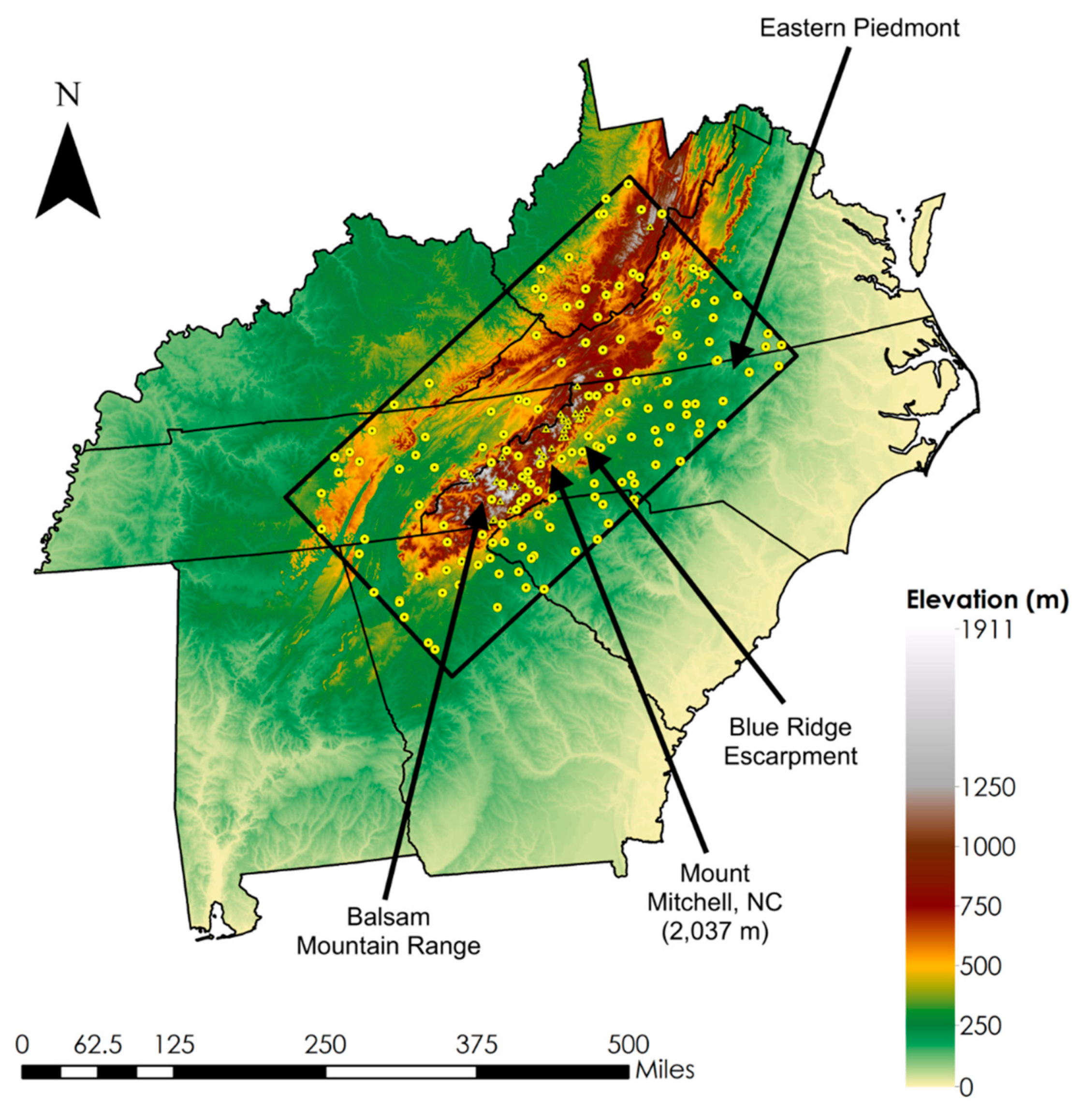

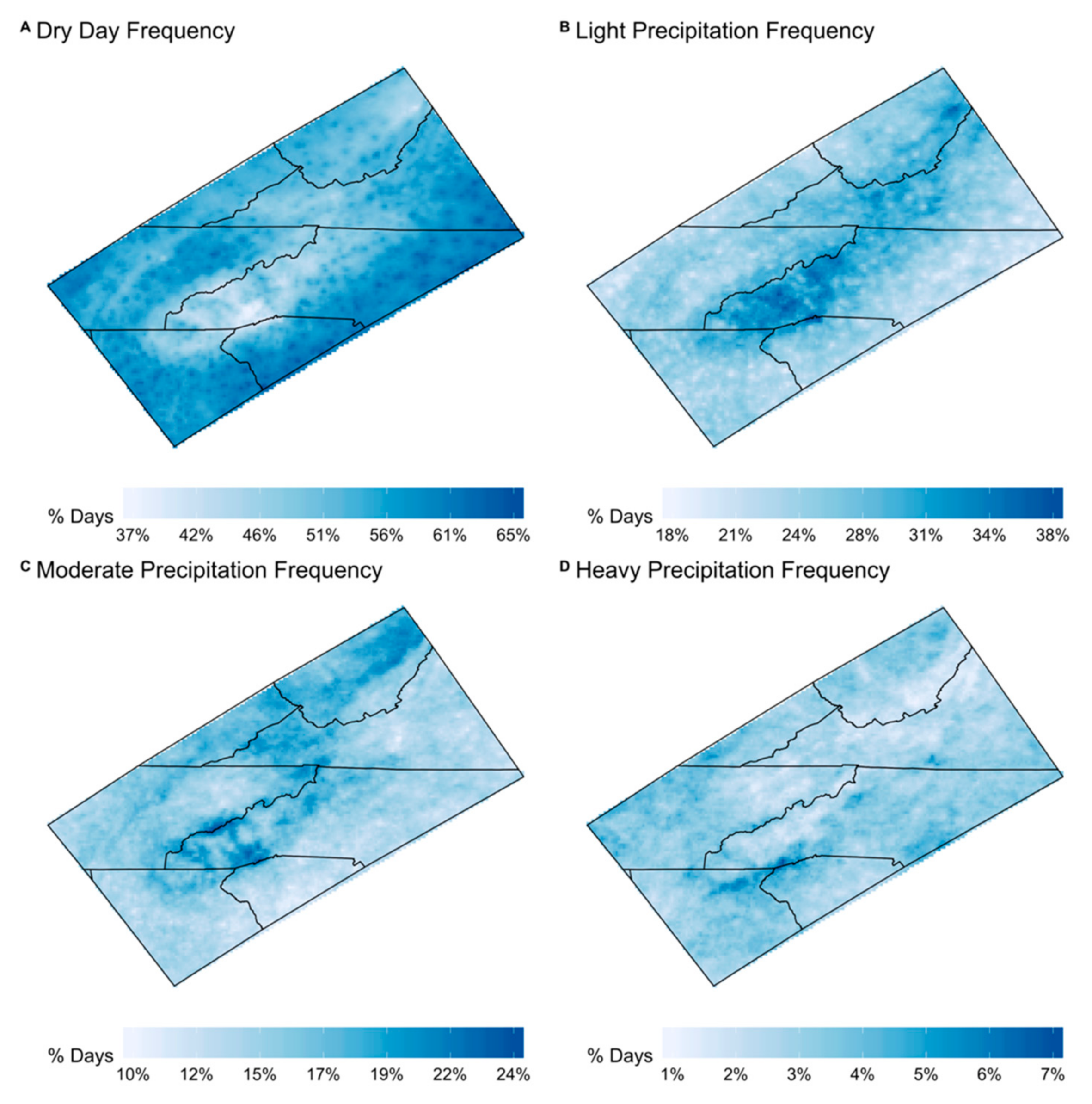
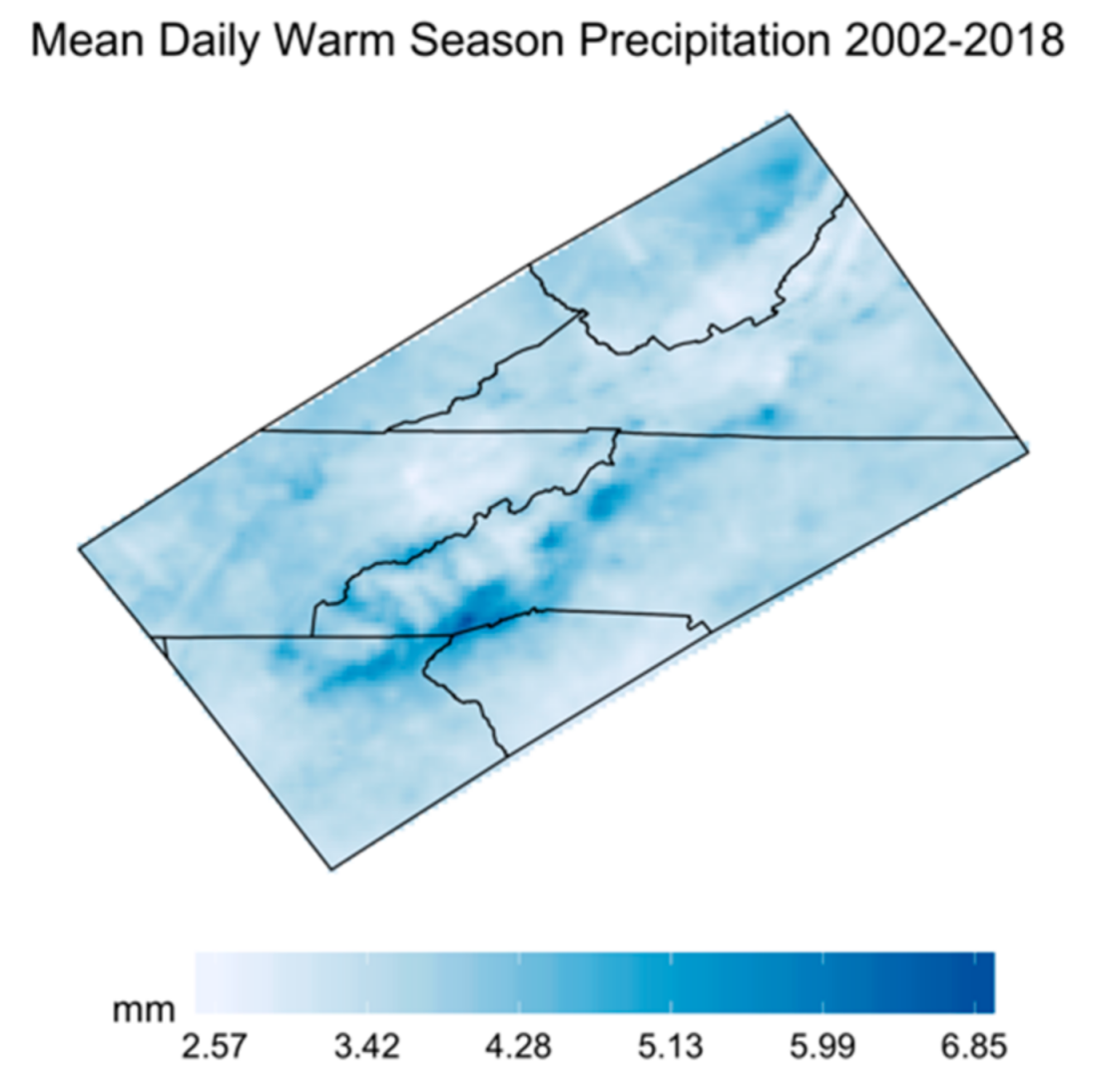
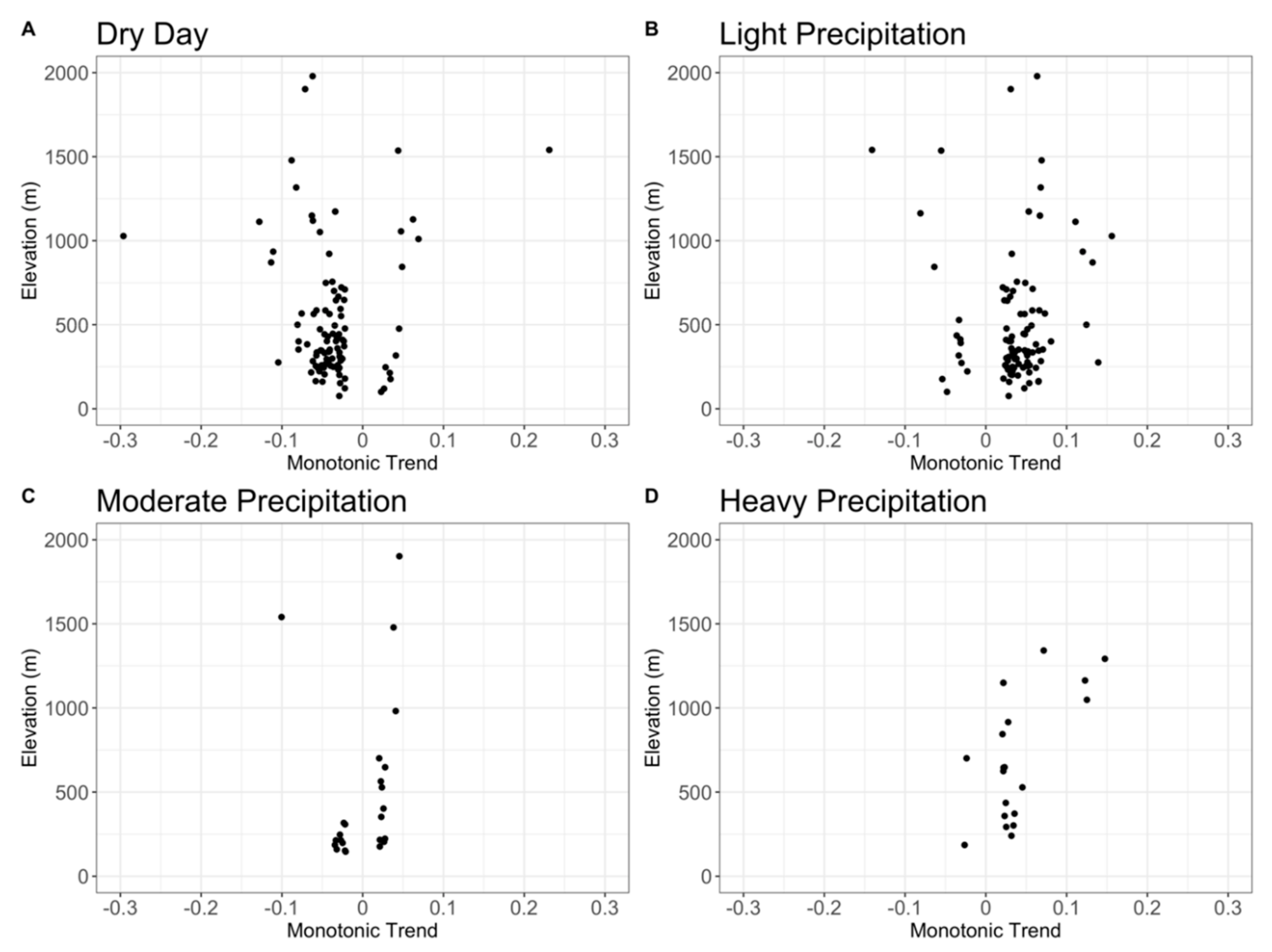
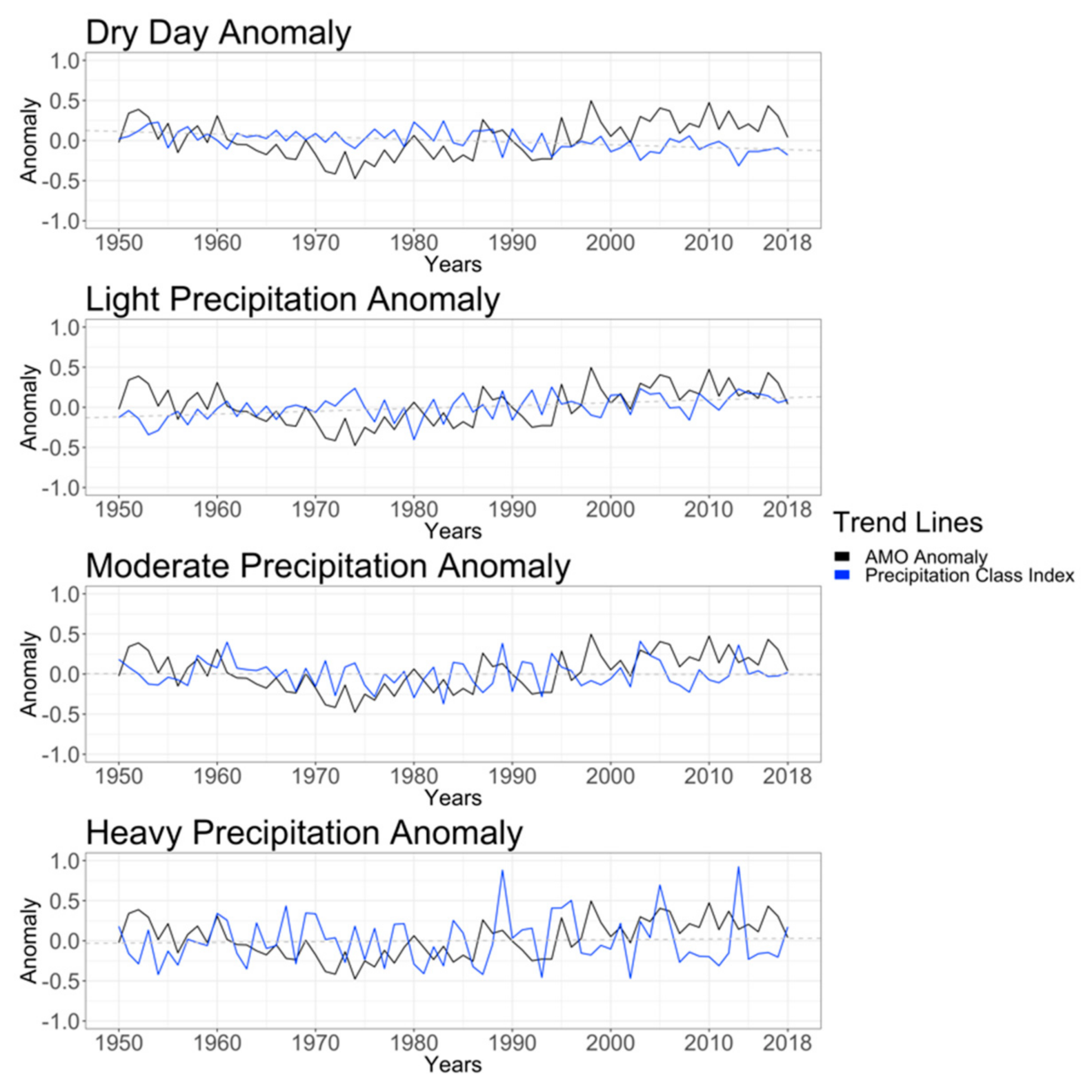

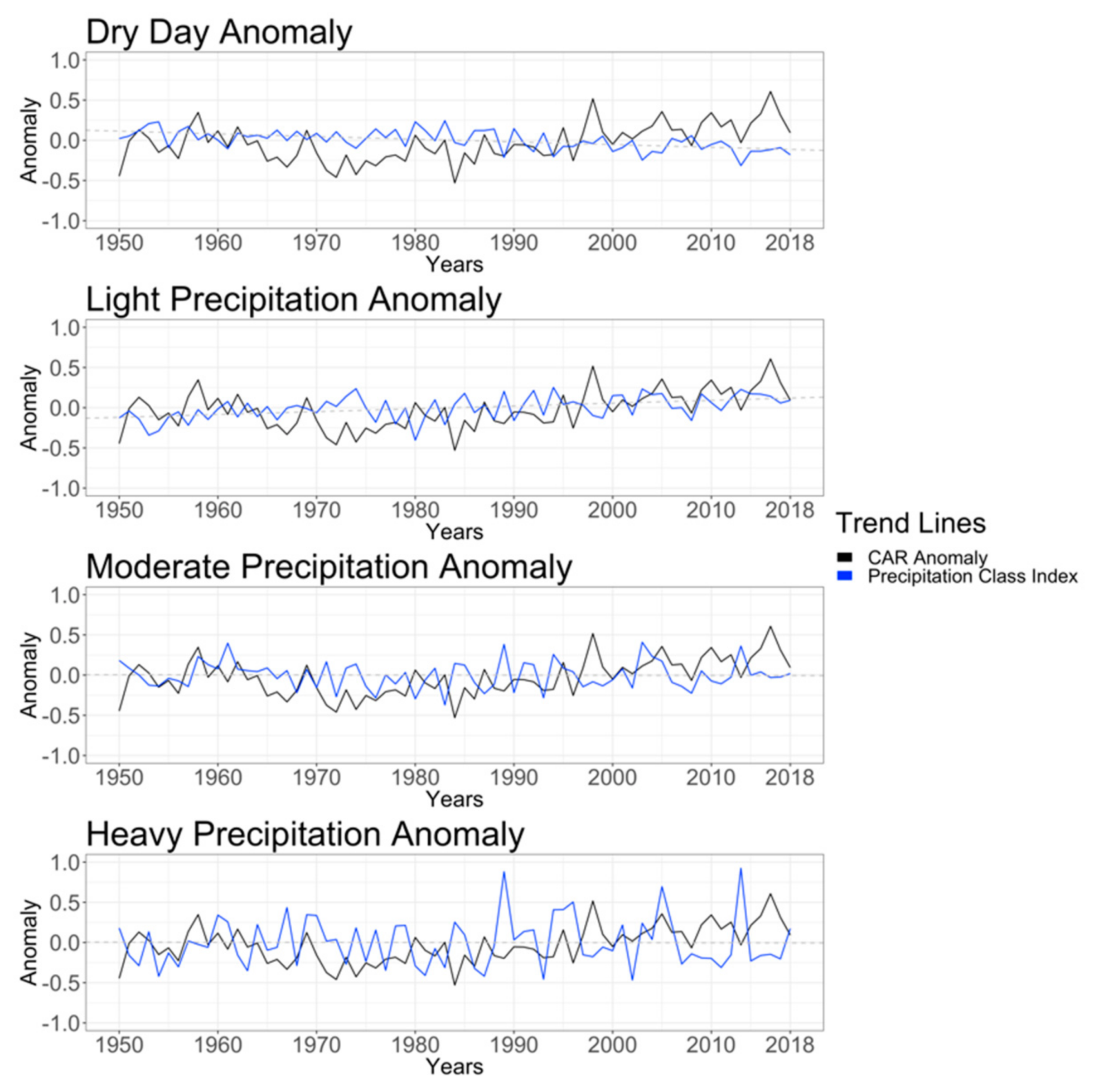
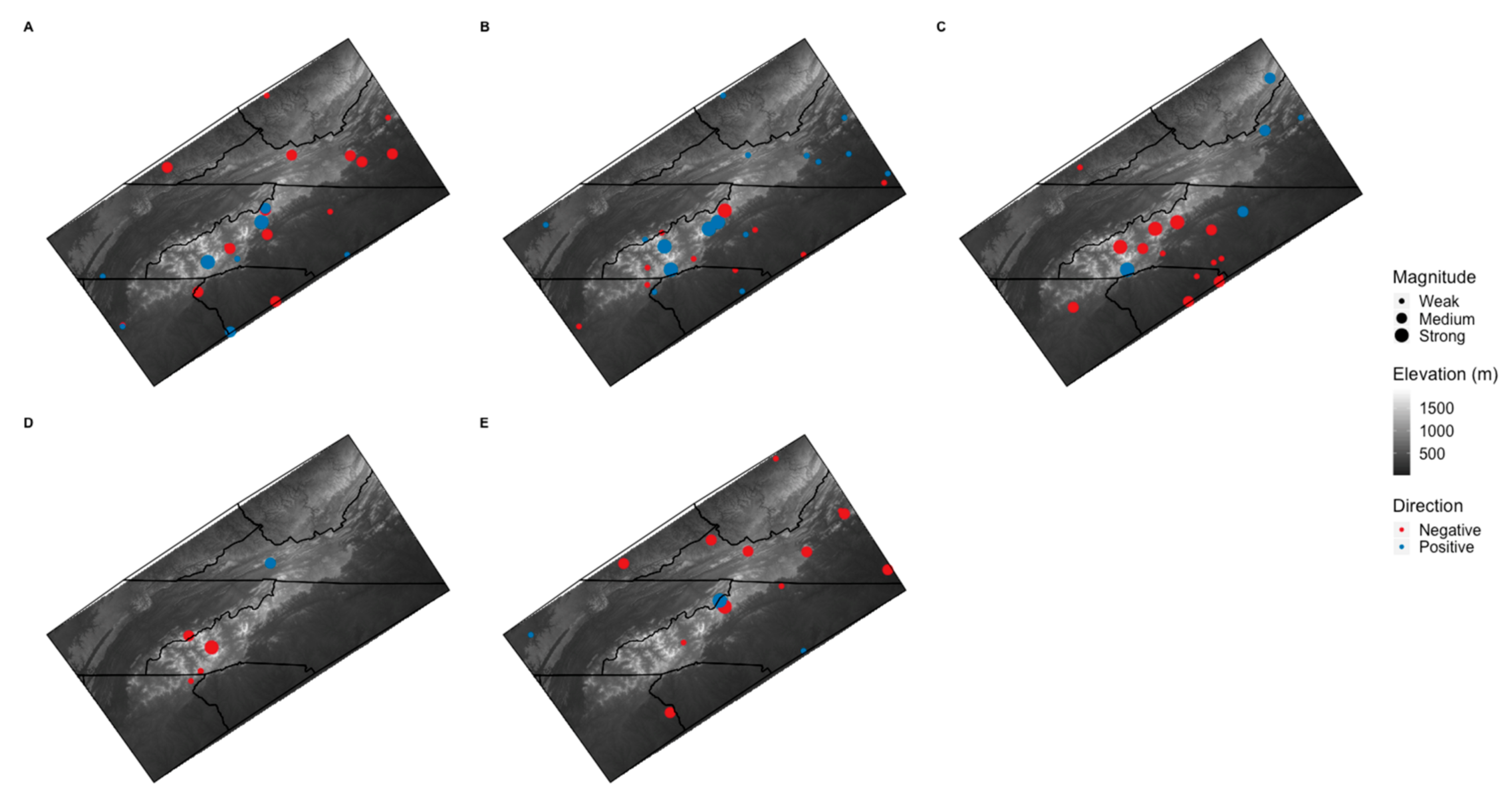
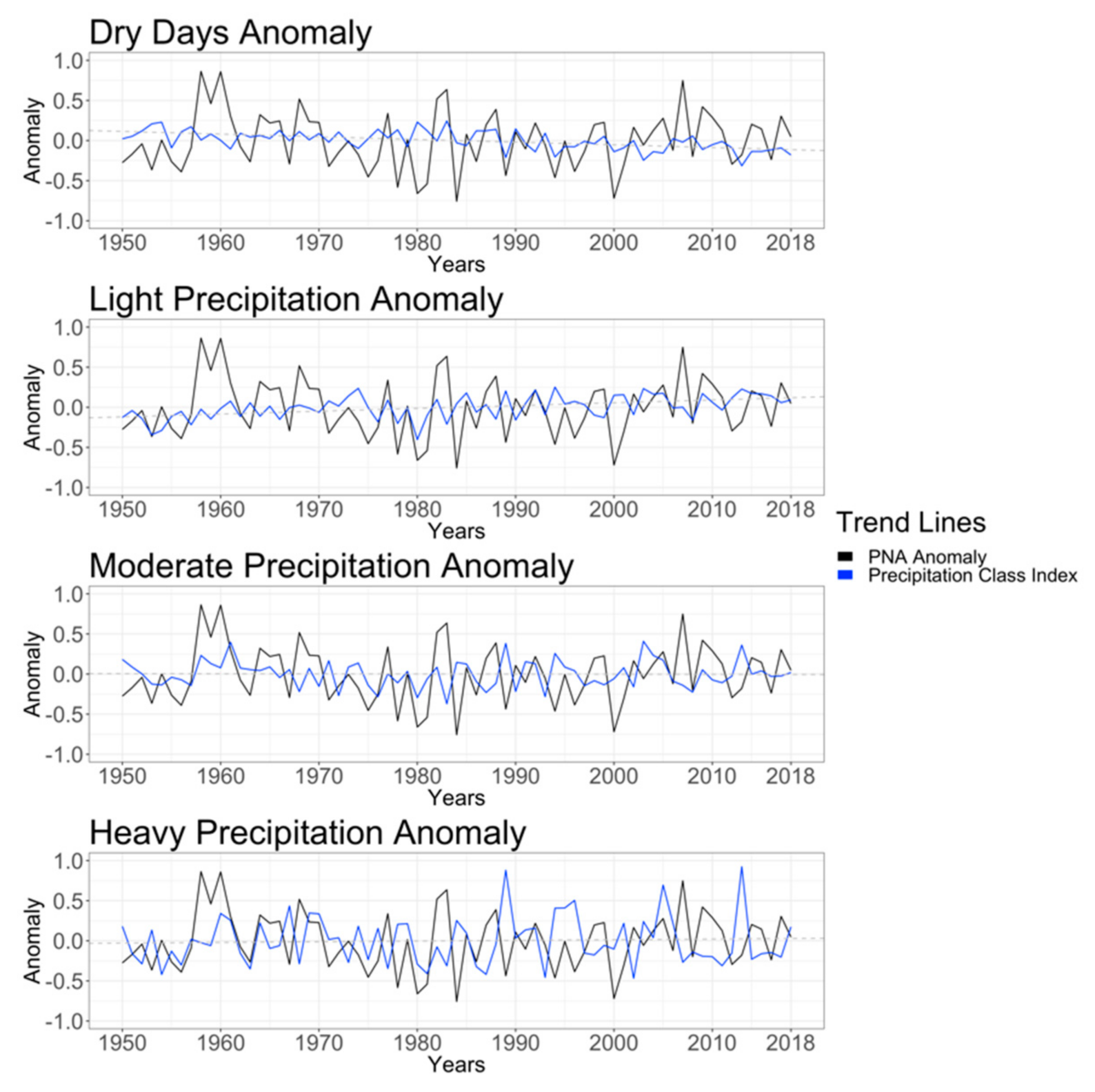
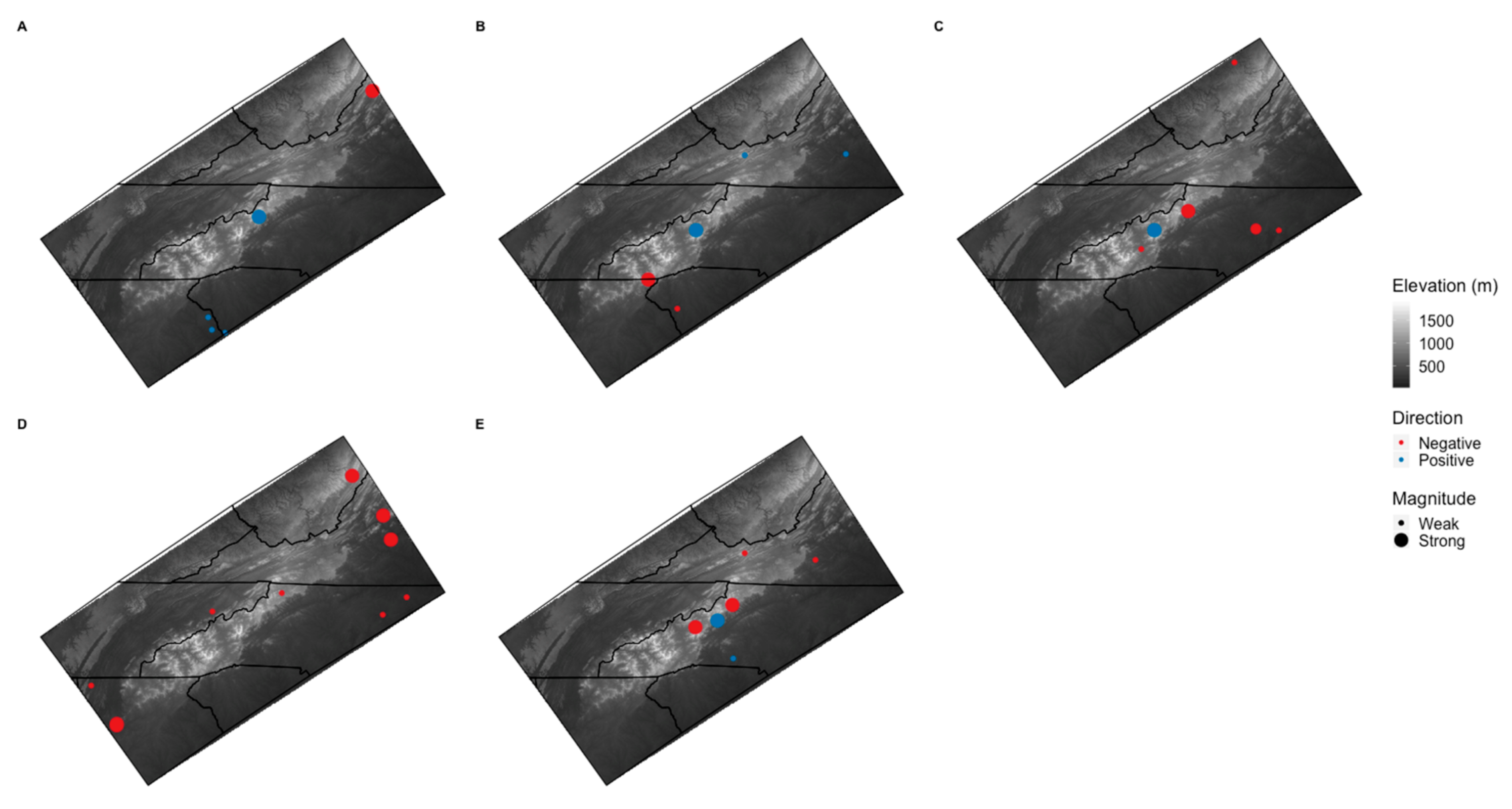
| Dry | Light | Moderate | Heavy |
|---|---|---|---|
| <0.254 mm | 0.254 mm–6.35 mm | 6.35 mm–25.4 mm | >25.4 mm |
| Negative | Positive | |
|---|---|---|
| Dry | ||
| Light | ||
| Moderate | ||
| Heavy | ||
| DSL |
| Negative | Positive | |
|---|---|---|
| Dry | 7 | |
| Light | ||
| Moderate | ||
| Heavy | ||
| DSL |
| Negative | Positive | |
|---|---|---|
| Dry | 8 | |
| Light | ||
| Moderate | ||
| Heavy | ||
| DSL |
| Negative | Positive | |
|---|---|---|
| Dry | 4 | |
| Light | ||
| Moderate | ||
| Heavy | ||
| DSL |
© 2019 by the authors. Licensee MDPI, Basel, Switzerland. This article is an open access article distributed under the terms and conditions of the Creative Commons Attribution (CC BY) license (http://creativecommons.org/licenses/by/4.0/).
Share and Cite
Kinlaw, T.; Sugg, J.W.; Perry, L.B. Warm Season Hydroclimatic Variability and Change in the Appalachian Region of the Southeastern U.S. from 1950 to 2018. Atmosphere 2019, 10, 289. https://doi.org/10.3390/atmos10050289
Kinlaw T, Sugg JW, Perry LB. Warm Season Hydroclimatic Variability and Change in the Appalachian Region of the Southeastern U.S. from 1950 to 2018. Atmosphere. 2019; 10(5):289. https://doi.org/10.3390/atmos10050289
Chicago/Turabian StyleKinlaw, Timothy, Johnathan W. Sugg, and L. Baker Perry. 2019. "Warm Season Hydroclimatic Variability and Change in the Appalachian Region of the Southeastern U.S. from 1950 to 2018" Atmosphere 10, no. 5: 289. https://doi.org/10.3390/atmos10050289
APA StyleKinlaw, T., Sugg, J. W., & Perry, L. B. (2019). Warm Season Hydroclimatic Variability and Change in the Appalachian Region of the Southeastern U.S. from 1950 to 2018. Atmosphere, 10(5), 289. https://doi.org/10.3390/atmos10050289




